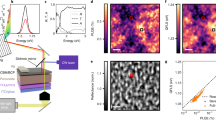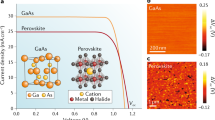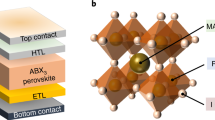Abstract
Photovoltaic devices based on hybrid perovskite materials have exceeded 22% efficiency due to high charge-carrier mobilities and lifetimes. Properties such as photocurrent generation and open-circuit voltage are influenced by the microscopic structure and orientation of the perovskite crystals, but are difficult to quantify on the intra-grain length scale and are often treated as homogeneous within the active layer. Here, we map the local short-circuit photocurrent, open-circuit photovoltage, and dark drift current in state-of-the-art methylammonium lead iodide solar cells using photoconductive atomic force microscopy. We find, within individual grains, spatially correlated heterogeneity in short-circuit current and open-circuit voltage up to 0.6 V. These variations are related to different crystal facets and have a direct impact on the macroscopic power conversion efficiency. We attribute this heterogeneity to a facet-dependent density of trap states. These results imply that controlling crystal grain and facet orientation will enable a systematic optimization of polycrystalline and single-crystal devices for photovoltaic and lighting applications.
This is a preview of subscription content, access via your institution
Access options
Subscribe to this journal
Receive 12 digital issues and online access to articles
$119.00 per year
only $9.92 per issue
Buy this article
- Purchase on Springer Link
- Instant access to full article PDF
Prices may be subject to local taxes which are calculated during checkout





Similar content being viewed by others
References
Burschka, J. et al. Sequential deposition as a route to high-performance perovskite-sensitized solar cells. Nature 499, 316–319 (2013).
Eperon, G. E., Burlakov, V. M., Docampo, P., Goriely, A. & Snaith, H. J. Morphological control for high performance, solution-processed planar heterojunction perovskite solar cells. Adv. Funct. Mater. 24, 151–157 (2014).
Li, Y. et al. Fabrication of planar heterojunction perovskite solar cells by controlled low-pressure vapor annealing. J. Phys. Chem. Lett. 6, 493–499 (2015).
Noh, J. H., Im, S. H., Heo, J. H., Mandal, T. N. & Seok, S. I. Chemical management for colorful, efficient, and stable inorganic–organic hybrid nanostructured solar cells. Nano Lett. 13, 1764–1769 (2013).
Tanaka, K. et al. Comparative study on the excitons in lead-halide-based perovskite-type crystals CH3NH3PbBr3 CH3NH3PbI3 . Solid State Commun. 127, 619–623 (2003).
Hao, F., Stoumpos, C. C., Chang, R. P. H. & Kanatzidis, M. G. Anomalous band gap behavior in mixed Sn and Pb perovskites enables broadening of absorption spectrum in solar cells. J. Am. Chem. Soc. 136, 8094–8099 (2014).
Sum, T. C. & Mathews, N. Advancements in perovskite solar cells: photophysics behind the photovoltaics. Energy Environ. Sci. 7, 2518–2534 (2014).
Tan, Z.-K. et al. Bright light-emitting diodes based on organometal halide perovskite. Nature Nanotech. 9, 687–692 (2014).
Kazim, S., Nazeeruddin, M. K., Grätzel, M. & Ahmad, S. Perovskite as light harvester: a game changer in photovoltaics. Angew. Chem. Int. Ed. 53, 2812–2824 (2014).
National Renewable Energy Laboratory Best Research-Cell Efficiencieswww.nrel.gov/ncpv/images/efficiency_chart.jpg (accessed 17 May 2016).
Li, G. et al. Efficient light-emitting diodes based on nanocrystalline perovskite in a dielectric polymer matrix. Nano Lett. 15, 2640–2644 (2015).
Xing, G. et al. Low-temperature solution-processed wavelength-tunable perovskites for lasing. Nature Mater. 13, 476–480 (2014).
Hu, X. et al. High-performance flexible broadband photodetector based on organolead halide perovskite. Adv. Funct. Mater. 24, 7373–7380 (2014).
Stranks, S. D. et al. Electron-hole diffusion lengths exceeding 1 micrometer in an organometal trihalide perovskite absorber. Science 342, 341–344 (2013).
Xing, G. et al. Long-range balanced electron- and hole-transport lengths in organic-inorganic CH3NH3PbI3 . Science 342, 344–347 (2013).
Dong, Q. et al. Electron-hole diffusion lengths >175 μm in solution grown CH3NH3PbI3 single crystals. Science 347, 967–970 (2015).
Wehrenfennig, C., Eperon, G. E., Johnston, M. B., Snaith, H. J. & Herz, L. M. High charge carrier mobilities and lifetimes in organolead trihalide perovskites. Adv. Mater. 26, 1584–1589 (2014).
Oga, H., Saeki, A., Ogomi, Y., Hayase, S. & Seki, S. Improved understanding of the electronic and energetic landscapes of perovskite solar cells: high local charge carrier mobility, reduced recombination, and extremely shallow traps. J. Am. Chem. Soc. 136, 13818–13825 (2014).
Edri, E. et al. Elucidating the charge carrier separation and working mechanism of CH3NH3PbI3−xClx perovskite solar cells. Nature Commun. 5, 3461 (2014).
Bergmann, V. W. et al. Real-space observation of unbalanced charge distribution inside a perovskite-sensitized solar cell. Nature Commun. 5, 5001 (2014).
Yun, J. S. et al. Benefit of grain boundaries in organic–inorganic halide planar perovskite solar cells. J. Phys. Chem. Lett. 6, 875–880 (2015).
deQuilettes, D. W. et al. Impact of microstructure on local carrier lifetime in perovskite solar cells. Science 348, 683–686 (2015).
Bischak, C. G., Sanehira, E. M., Precht, J. T., Luther, J. M. & Ginsberg, N. S. Heterogeneous charge carrier dynamics in organic–inorganic hybrid materials: nanoscale lateral and depth-dependent variation of recombination rates in methylammonium lead halide perovskite thin films. Nano Lett. 15, 4799–4807 (2015).
Tress, W. et al. Predicting the open-circuit voltage of CH3NH3PbI3 perovskite solar cells using electroluminescence and photovoltaic quantum efficiency spectra: the role of radiative and non-radiative recombination. Adv. Energy Mater. 5, 1400812 (2015).
Ballif, C., Moutinho, H. R. & Al-Jassim, M. M. Cross-sectional electrostatic force microscopy of thin-film solar cells. J. Appl. Phys. 89, 1418–1424 (2001).
Visoly-Fisher, I., Cohen, S. R., Gartsman, K., Ruzin, A. & Cahen, D. Understanding the beneficial role of grain boundaries in polycrystalline solar cells from single-grain-boundary scanning probe microscopy. Adv. Funct. Mater. 16, 649–660 (2006).
Groves, C., Reid, O. G. & Ginger, D. S. Heterogeneity in polymer solar cells: local morphology and performance in organic photovoltaics studied with scanning probe microscopy. Acc. Chem. Res. 43, 612–620 (2010).
Chen, B. et al. Impact of capacitive effect and ion migration on the hysteretic behavior of perovskite solar cells. J. Phys. Chem. Lett. 6, 4693–4700 (2015).
Nie, W. et al. High-efficiency solution-processed perovskite solar cells with millimeter-scale grains. Science 347, 522–525 (2015).
Abass, A., Gestel, D. V., Wichelen, K. V., Maes, B. & Burgelman, M. On the diffusion length and grain size homogeneity requirements for efficient thin-film polycrystalline silicon solar cells. J. Phys. Appl. Phys. 46, 45105 (2013).
Williams, S. T. et al. Role of chloride in the morphological evolution of organo-lead halide perovskite thin films. ACS Nano 8, 10640–10654 (2014).
Tidhar, Y. et al. Crystallization of methyl ammonium lead halide perovskites: implications for photovoltaic applications. J. Am. Chem. Soc. 136, 13249–13256 (2014).
Yu, H. et al. The role of chlorine in the formation process of ‘CH3NH3PbI3-xClx’ perovskite. Adv. Funct. Mater. 24, 7102–7108 (2014).
Noel, N. K. et al. Enhanced photoluminescence and solar cell performance via Lewis base passivation of organic–inorganic lead halide perovskites. ACS Nano 8, 9815–9821 (2014).
Guerrero, A., Juarez-Perez, E. J., Bisquert, J., Mora-Sero, I. & Garcia-Belmonte, G. Electrical field profile and doping in planar lead halide perovskite solar cells. Appl. Phys. Lett. 105, 133902 (2014).
Ball, J. M., Lee, M. M., Hey, A. & Snaith, H. J. Low-temperature processed meso-superstructured to thin-film perovskite solar cells. Energy Environ. Sci. 6, 1739–1743 (2013).
Yuan, Y. et al. Photovoltaic switching mechanism in lateral structure hybrid perovskite solar cells. Adv. Energy Mater. 5, 1500615 (2015).
Eames, C. et al. Ionic transport in hybrid lead iodide perovskite solar cells. Nature Commun. 6, 7497 (2015).
Leguy, A. M. A. et al. The dynamics of methylammonium ions in hybrid organic-inorganic perovskite solar cells. Nature Commun. 6, 7124 (2015).
Li, J. & Haney, P. M. Molecular alignment and Rashba splitting in organometal halide perovskite CH3NH3PbI3 absorbers. In Photovoltaic Specialist Conference (PVSC), 2015 IEEE 42ndhttp://dx.doi.org/10.1109/PVSC.2015.7355729 (2015).
Coll, M. et al. Polarization switching and light-enhanced piezoelectricity in lead halide perovskites. J. Phys. Chem. Lett. 6, 1408–1413 (2015).
She, L., Liu, M. & Zhong, D. Atomic structures of CH3NH3PbI3 (001) surfaces. ACS Nano 10, 1126–1131 (2016).
van der Walt, S. et al. scikit-image: image processing in Python. PeerJ 2, e453 (2014).
Perdew, J. P., Burke, K. & Ernzerhof, M. Generalized gradient approximation made simple. Phys. Rev. Lett. 77, 3865–3868 (1996).
Blöchl, P. E. Projector augmented-wave method. Phys. Rev. B 50, 17953–17979 (1994).
Kresse, G. & Furthmüller, J. Efficient iterative schemes for ab initio total-energy calculations using a plane-wave basis set. Phys. Rev. B 54, 11169–11186 (1996).
Acknowledgements
This material is based on work supported by the National Science Foundation Graduate Research Fellowship under Grant No. (NSF DGE 1106400) and by the Joint Center for Artificial Photosynthesis, a DOE Energy Innovation Hub, supported through the Office of Science of the US Department of Energy under Award Number DE-SC0004993. L.L. thanks the AvH foundation for financial support through the Feodor-Lynen program. D.Z. acknowledges support by the US Department of Energy, Office of Science, SBIR/STTR Program Office, under Award Number DE-SC0013212. A.W.-B., M.M., J.L. and S.Y.L. were supported by a DOE Early Career Grant. Work at the Molecular Foundry was supported by the US Department of Energy (DOE), Office of Basic Energy Sciences, Scientific User Facilities Division, under contract no. DE-AC02-05CH11231 and user proposal 4233. J.B.N., S.E.R.-L. and F.M.T. acknowledge support from the Laboratory Directed Research and Development Program at the Lawrence Berkeley National Laboratory under Contract No. DE-AC02-05CH11231.
Author information
Authors and Affiliations
Contributions
S.Y.L., L.L., F.M.T., I.D.S. and A.W.-B. conceived the work and designed the research strategy. S.Y.L. measured and analysed the cAFM data. E.W., M.M. and D.K.A. participated in and supported the development of the new cAFM technique. J.L., D.Z., P.D.A., D.F.O., S.W., F.M.T., I.D.S. and A.W.-B. participated in interpretation of the experimental data. L.L. and S.E.R.-L. performed the theoretical calculations supervised by J.B.N. Y.L. performed the sample preparation and macroscale characterization. I.D.S. and F.M.T. supervised the sample preparation and characterization. S.Y.L., L.L., D.F.O., I.D.S. and A.W.-B. wrote the manuscript with help from D.Z., P.D.A., and F.M.T. F.M.T., J.B.N., I.D.S. and A.W.-B. coordinated this research. All authors contributed to the scientific discussion and manuscript revisions.
Corresponding authors
Ethics declarations
Competing interests
The authors declare no competing financial interests.
Supplementary information
Supplementary Information
Supplementary Methods, Supplementary Notes 1–3, Supplementary Discussion, Supplementary Figures 1–20, Supplementary Tables 1 and 2, Supplementary References. (PDF 2030 kb)
Rights and permissions
About this article
Cite this article
Leblebici, S., Leppert, L., Li, Y. et al. Facet-dependent photovoltaic efficiency variations in single grains of hybrid halide perovskite. Nat Energy 1, 16093 (2016). https://doi.org/10.1038/nenergy.2016.93
Received:
Accepted:
Published:
DOI: https://doi.org/10.1038/nenergy.2016.93
This article is cited by
-
Structure sensitivity in gas sorption and conversion on metal-organic frameworks
Nature Communications (2023)
-
Weak UV-Stimulated Synaptic Transistors Based on Precise Tuning of Gallium-Doped Indium Zinc Oxide Nanofibers
Advanced Fiber Materials (2023)
-
Advances and challenges in understanding the microscopic structure–property–performance relationship in perovskite solar cells
Nature Energy (2022)
-
Ultrafast transient infrared spectroscopy for probing trapping states in hybrid perovskite films
Communications Chemistry (2022)
-
Out-of-equilibrium processes in crystallization of organic-inorganic perovskites during spin coating
Nature Communications (2021)



